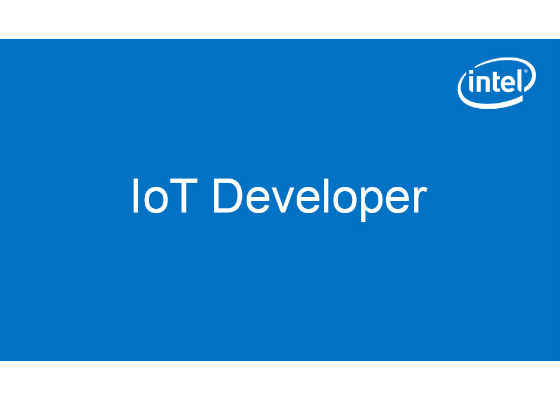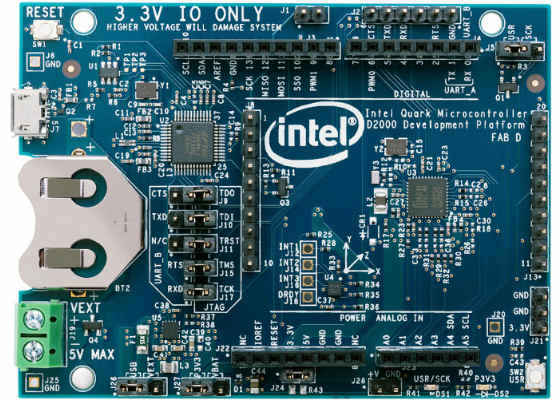Where to Use the Intel Quark Microcontroller D2000

Overview
This article introduces you to the Intel® Quark™ microcontroller D2000 and shows you where you can use it in your designs.
Microcontrollers and The Internet Of Things (IoT)
Intel wants to be at the center of connected hardware. From the servers in the cloud to the gateways that connect devices to the internet, and, now, all the way to the edge of the internet in the sensors gathering data. The Intel® Quark™ microcontroller D2000 is a 32-bit x86 Pentium® processor in a microcontroller package. Engineered for low power consumption, this microcontroller is designed to be the heart of battery-operated sensor devices. With the goal of bringing intelligence to the edge of the Internet of Things (IoT), the Intel® Quark™ microcontroller D2000 makes sensors smarter with the ability to not only read data and pass it on, but to analyze the data and independently take appropriate actions.
If a sensor device loses its connection to the cloud, a smart sensor equipped with the Intel® Quark™ microcontroller D2000 can log data and operate autonomously until the connection returns. If the smart sensor recognizes that a problem has occurred, it can take action locally, instead of sending the data to the cloud and waiting for instructions. Pushing intelligence to the devices at the edge of the IoT reduces the need for complex and expensive gateways, limits the network bandwidth required to support the growing number of sensors talking to the cloud. The power of the IoT is not just in controlling things, but in the data that connected sensors generate.
Within data, there are patterns which are recognizable by smart sensors that learn and get smarter. The patterns are everywhere and the Intel® Quark™ microcontroller D2000 can make sensors smarter to recognize them.
With an x86 instruction set compatible processor at its core, the Intel® Quark™ microcontroller D2000 can run software written for desktop computers. Decades of software development for the x86 processor has produced a highly optimized set of tools that are perfect for making compact software to run on battery-powered resource limited devices. The Intel® Quark™ microcontroller D2000, based on a Pentium® processor, has one of the lowest power 32-bit processors available. The combination of powerful processing and low power along with a complete set of peripherals makes the Intel® Quark™ microcontroller D2000 ideal for IoT. Let’s now take a look at some areas where this microcontroller can be used to power the IoT.
Features of the Intel® Quark™ Microcontroller D2000
Package
Coming in a 40-pin surface mount package, this microcontroller is less than a quarter inch by a quarter inch making it ideal for small sensor devices.
Integrated and Internal Features
It includes a number of features designed to reduce the number of required external components. It has an integrated regulator to power itself and attached sensors. It’s also designed to run directly from batteries and able to tolerate the large voltage range of discharging batteries. It can additionally run without an external crystal and has internal flash memory to retain sensor data after the power runs out.
Power
Running at full power, the Intel® Quark™ microcontroller D2000 consumes only 8mA. Low power sleep modes can limit current to nanoAmps. With proper software design, a sensor device (based on the Intel® Quark™ microcontroller D2000) could run for a couple years on a 9-Volt lithium-ion battery.
Peripherals
The Intel® Quark™ microcontroller D2000 comes with an array of peripherals around the x86 processor core. It has standard communication hardware for talking to sensors: I2C*, SPI, and UART. To read analog sensors, it has Analog-to-Digital Converters (ADCs).
It has timers for triggering periodic sensor readings or for controlling the brightness of an LED for feedback.
Clock and Security
The Intel® Quark™ microcontroller D2000 has a Real-Time Clock for keeping track of the passage of time, information that’s often important for data logging. It also has security features to prevent sensor devices from becoming a network entry point for hackers.
The Intel® Quark™ microcontroller D2000 has been created from the ground up for IoT. Let’s take a look at some applications.
Applications
Smart Buildings and Homes
The Intel® Quark™ microcontroller D2000 can be used for building a wireless home automation system. You could build wireless, battery powered sensors for taking measurements around the house. With the same microcontroller you could then send that data to the internet, process it and access the data from anywhere. You could track your pets, enable your plants to send you a text requesting to be watered, or detect a water leak. In an office environment, you could install wireless light sensors, controlled by the Intel® Quark™ microcontroller D2000, to measure current lighting conditions and dim overhead lights when there’s enough light coming through the windows. In the home, it can also monitor current conditions and make changes in response. Let’s look at one idea for a home automation system.
Connected Thermostat with Wireless Temperature Sensors
By connecting the Intel® Quark™ microcontroller D2000 to a temperature sensor, a Bluetooth® low energy radio, and a coin cell battery, you can create wireless, battery-powered, temperature sensors. You could position the temperature sensors throughout the house.
Instead of measuring the temperature just at one place on one floor, you could measure the temperature in every room. You could prioritize the temperature of some rooms over others to decide which rooms are more important. With Bluetooth® technology, you can transmit that data back to a central thermostat which could have the same Intel® Quark™ microcontroller D2000 in it.
In the thermostat, the Intel® Quark™ microcontroller D2000 could control your furnace, turning on and off relays, and reading the status of the air conditioner, the furnace, and the fan. You could add an interface with switches, knobs, and a display to control the thermostat locally and to build schedules. The thermostat could be connected to the internet with a Wi-Fi module that could talk to your router to send and receive messages from the cloud. The connected thermostat could be controlled from anywhere in the world. With built-in security on the Intel® Quark™ microcontroller D2000, you can be sure that your data remains
secure. With the data you gather over time, patterns will emerge that will support long term decisions like replacing windows or improving insulation. Then, you will be able to directly quantify the improvements by comparing new patterns to old ones. Of course, this is just one example. Anywhere there is data to be gathered, you can use the Intel® Quark™ microcontroller D2000 to build sensors that will help people make better informed decisions with measurable results.
Industrial Applications
Automation is an essential part of modern industry. The Internet of Things presents an enormous opportunity to expand automation in manufacturing. Wireless battery-powered sensor devices can gather data to improve efficiency and reduce downtime by recognizing problems and notifying the appropriate people to perform maintenance. With sensor nodes, powered by the Intel® Quark™ microcontroller D2000, machines and processes can be managed remotely. New lower cost, battery-powered sensors can be installed without running new cables for power and communication. With the Intel® Quark™ microcontroller D2000, remote sensors can be made intelligent, to operate autonomously in remote locations even if the network is unavailable. Combined with new developments in wireless technologies, this microcontroller can power low-power networks covering large areas. An example would be a long range wireless industrial sensor network.
Transportation
Transportation is another industry where the Intel® Quark™ microcontroller D2000 can power the Internet of Things. As in industrial applications, transportation systems can be monitored with wireless sensor networks. Pairing the microcontroller with a GPS radio, buses can be tracked. It could relay the position information over a cellular network to the cloud. Applications in the cloud could analyze position and traffic information from the internet to accurately predict arrival and departure times. A mobile application could access the cloud data to keep riders informed. The microcontroller could also power wireless occupancy sensors at bus stops to assess which stops require service or to drive displays providing information to riders. By gathering data and putting it in the hands of the right people, the Intel® Quark™ microcontroller D2000 will play an important role in improving transportation for growing cities.
NFC Fare Card System
Public transportation systems have increasingly moved away from cash and fare cards, instead relying on permanent user fare cards and cellphones equipped with secure Near-Field Communication, or NFC, technology. NFC works with a reader which generates an electric field. When the card moves into the electric field, it gets power from the electric field and communicates back to the reader by manipulating the electric field. The NFC electrical field is small, not supplying substantial power. The Intel® Quark™ microcontroller D2000 is ideal for low power applications and works well as a controller for secure fare cards. With the Intel® Quark™ microcontroller D2000 and its onboard security features, the NFC system could be protected against hacking. It could also power the fare card reader, providing a secure microcontroller for communicating with servers in the cloud. Usage data from the NFC reader could be used to improve transportation systems to operate at peak efficiency, adding trains or busses during predicted busy times and reducing fleet operations when traffic is expected to be light. Patterns that emerge from the data can inform long term decision making that can affect millions of people.
Development Tools
The Intel® Quark™ microcontroller Developer Kit D2000
Figure 1. Intel® Quark™ microcontroller Developer Kit D2000
The Intel® Quark™ microcontroller Developer Kit D2000 is built to get you started developing devices for the Internet of Things. In addition to the microcontroller, the Development Kit contains a 6-axis IMU with accelerometers and magnetometers, USB connectivity for programming and debugging, a coin cell battery holder, and memory for storing data. The kit has headers to interface with 3.3V compatible Arduino shields and Launchpad Booster packs. Pairing the microcontroller with any of the dozens of available sensor shields and a radio, you can create an IoT device.
Intel® System Studio for Microcontrollers
Intel provides free software tools for developing with the Intel® Quark™ microcontroller D2000. Intel® System Studio for Microcontrollers (ISSM) is a robust, full-featured, complete integrated development environment. ISSM comes with a complete set of software tools that make it simple to develop your own IoT applications. Loaded with examples, you can find software that performs just about any function and that automates reading a wide variety of sensors and communicates with an array of radios. Download it for free at Intel® System Studio for Microcontrollers.
The Zephyr* Real-time Operating System (RTOS)
Intel, in partnership with the Linux Foundation*, developed a free, open-source real time operating system, RTOS, to support the Intel® Quark™ microcontroller D2000 and a range of other microcontrollers. The Zephyr* RTOS has been created with a focus on enabling developers to quickly build IOT devices. With comprehensive libraries and a highly optimized core, the Zephyr RTOS is the ideal choice for developers using the Intel® Quark™ microcontroller D2000. For more information on the Zephyr RTOS, check out theZephyr Project Documentation.
For more such intel IoT resources and tools from Intel, please visit the Intel® Developer Zone
Source: https://software.intel.com/en-us/articles/where-to-use-the-intel-quark-microcontroller-d2000





